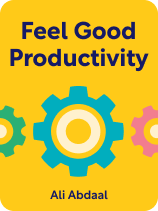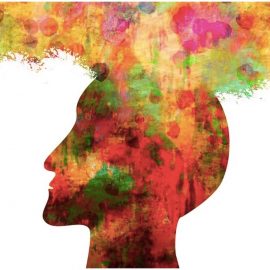

This article is an excerpt from the Shortform book guide to "Feel-Good Productivity" by Ali Abdaal. Shortform has the world's best summaries and analyses of books you should be reading.
Like this article? Sign up for a free trial here.
What’s feel-good productivity? Do you want to feel energetic while working?
According to Ali Abdaal, productivity doesn’t have to be hard. There’s a way to get your work done while also feeling good about yourself and the tasks you’ve accomplished.
Keep reading if you’re tired of feeling burned out while working.
What’s Feel-Good Productivity?
Ali Abdaal’s productivity model is based on the idea that work not only can be enjoyable, but it should be enjoyable. When work feels good, it energizes you instead of drains you, meaning you can get a lot more done. Therefore, feel-good productivity not only boosts your emotional well-being, it also benefits the people who rely on you. (Shortform note: Interviewing Abdaal, Cal Newport (Deep Work) describes feel-good productivity as “philosophically aligned” with his idea of slow productivity—going after purposeful accomplishments without burning out. Both authors present an alternative form of productivity that pushes back against hustle culture.)
Abdaal bases his model of feel-good productivity on the broaden-and-build theory of positive emotions. The broaden-and-build theory states that feeling good isn’t just a brief reward for accomplishing something; those positive emotions directly lead to even greater accomplishments.
When you feel good, you’re more receptive to new information and more likely to think of creative ideas—in other words, feeling good broadens your mind. Good feelings also build a reserve of mental and emotional energy that you can tap as needed.
(Shortform note: The broaden-and-build theory was originally proposed in 1998; since then, numerous studies have confirmed these benefits of positive emotions. While it was already reasonable to assume that positive feelings directly counteract negative feelings, we now have formal research confirming that. For example, studies have shown that being scared or angry narrows your attention (sometimes called “tunnel vision”), and feeling sad or overwhelmed drains energy from that mental and emotional reserve we mentioned before.)
Abdaal adds that feel-good productivity is in direct opposition to the “grind” that modern culture glamorizes. The popular theory of productivity today is based on discipline and endurance: How much can you force yourself to do? How much stress can you withstand? However, as will become clear throughout this guide, that’s the opposite of how people naturally work.
(Shortform note: Experts believe that the grind mindset (or, as earlier mentioned, hustle culture) became popular in the 1990s and early 2000s. It happened because some Silicon Valley tech startups—companies that started from almost nothing and became enormously profitable—credited their success to company cultures that promoted work and productivity over everything else. The message spread through other companies that hoped to emulate their successes and eventually through social media as influencers promised people that they could achieve all their dreams if they just worked harder. Notably, just 30 years later, much of Gen Z began rejecting the grind mindset saying that it’s toxic and based on false promises.)
The Virtuous Cycle of Feel-Good Productivity
Abdaal says that his model of feel-good productivity can be summed up as a virtuous cycle. A virtuous cycle is a system where each step feeds naturally into the next step, leading to better outcomes over time.
The feel-good productivity cycle is as follows:
- Feeling good boosts your energy.
- Energy boosts your productivity.
- Productivity makes you feel even better, and the cycle begins again.
(Shortform note: Abdaal’s explanation of the feel-good productivity cycle makes some assumptions that might not always hold true. For example, Abdaal assumes that everyone feels good when they finish tasks, but for people with depression or chronic pain, “feeling good” may not even be possible. He also assumes that more energy will translate to more productivity, but that’s not always the case—for instance, people with Attention Deficit Hyperactivity Disorder (ADHD) often have enormous amounts of energy, but they may not be able to channel it into useful work.)
The Science: Why Feel-Good Productivity Works
Abdaal, who trained as a medical doctor, says that feel-good productivity is effective because it harnesses people’s natural biology and neurology. In simple terms, your body and brain instinctively know when you’re working in a healthy way; they reward you for it with good feelings (to encourage you to keep working that way) and increased energy (so you’re able to keep working that way).
Abdaal explains that you feel positive emotions when your brain releases certain hormones, such as dopamine and serotonin. However, these hormones don’t just produce pleasant feelings, they also have a wide variety of effects that will make you more energetic and productive. For instance, the feeling of excitement comes from dopamine; dopamine also boosts your concentration so you can more effectively pursue the thing you’re excited about.
So, Abdaal designed the feel-good productivity model to help you work in ways that cause you to produce more of those attention- and energy-boosting hormones, and your good feelings let you know that you’re doing it correctly.
On the other hand, says Abdaal, the grind mindset taps into negative feelings that trigger the production of stress hormones such as adrenaline and cortisol.
In nature, these stress hormones would help us protect ourselves from danger and withstand pain. As such, they provide powerful short-term motivation, but they have harmful long-term effects. This is because we didn’t evolve to spend our whole lives feeling stressed and pressured, meaning we aren’t designed to be constantly flooded with adrenaline and cortisol.
Tip: Take a Scientific Approach
Abdaal emphasizes that everyone is different, and what makes one person feel good might not help someone else. The important thing is to figure out what works for you. Therefore, he urges you to think of yourself as a scientist as you integrate feel-good productivity into your life. This means experimenting with different ideas and seeing what the results are.
If a suggestion in this guide boosts your happiness and productivity, keep doing it; if not, then let it go. Forcing yourself to do everything Abdaal suggests is just another type of grind, and it’s therefore the opposite of the feel-good productivity mindset.
(Shortform note: To really think like a scientist, as Abdaal suggests, consider some best practices for running scientific experiments. One of the key rules about experiments is that you should only change one variable at a time. If you make a bunch of changes to your lifestyle right away, even if you do feel better afterward, you won’t know which change or changes are responsible for those good feelings. However, there’s another good reason to take things slowly: Making a lot of major changes all at once is overwhelming, and trying to do so usually leads to failure and discouragement. Therefore, it’s more realistic to aim for slow, steady improvements to your mood and your productivity.)

———End of Preview———
Like what you just read? Read the rest of the world's best book summary and analysis of Ali Abdaal's "Feel-Good Productivity" at Shortform.
Here's what you'll find in our full Feel-Good Productivity summary:
- How to stop procrastination at its source and avoid or recover from burnout
- The crucial link between emotional health and productivity
- How to work in ways that feel energizing instead of draining






